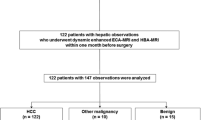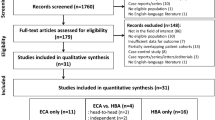Abstract
Objectives
To assess major imaging features of Liver Imaging Reporting and Data System (LI-RADS) on contrast-enhanced CT and gadoxetic acid-enhanced MRI and to estimate whether the combination of signal intensity favouring HCC on hepatobiliary phase (HBP) and diffusion-weighted images (DWI) can act as a major feature in LI-RADS.
Methods
Four hundred twenty one patients with 445 observations were included. Major features of LI-RADS on CT and MRI as well as HBP and DWI features were assessed. Diagnostic performances of LR-5 according to LI-RADS v2014 and modified LI-RADS which incorporate combination of HBP and DWI were assessed. Pairwise comparisons of the receiver operating characteristic (ROC) curves were performed.
Results
For HCCs, capsule appearance had the highest rate of discordance between CT and MRI (32.7%), followed by washout appearance (22.2%). Specificity (75%) of LR-5 of LI-RADS v2014 was lower than that (77.1–79.2%) of modified LI-RADS. Area under the ROC curve of modified LI-RADS (0.755–0.775) was not significantly different from that of LI-RADS v 2014 (0.709) (p > 0.05).
Conclusions
There were substantial discordances between CT and MRI for capsule and washout appearances in hepatic observations, and combination of gadoxetic acid-enhanced MRI and DWI might be able to be incorporated as a major feature of LI-RADS.
Key points
• Major imaging features of LI-RADS showed substantial discordances on CT and MRI.
• An observation may be categorized differently depending on used imaging exam.
• CT and MRI should both be performed for LR-3 and LR-4 observations.
• Combination of gadoxetic acid-enhanced MRI and DWI may be a major feature.






Similar content being viewed by others
Abbreviations
- AUC:
-
Area under the ROC curve
- CCC:
-
Cholangiocarcinoma
- CHC:
-
Combined hepatocellular-cholangiocarcinomas
- CI:
-
Confidence interval
- CT:
-
Computed tomography
- DWI:
-
Diffusion-weighted imaging
- HBP:
-
Hepatobiliary phase
- HCC:
-
Hepatocellular carcinoma
- LI-RADS:
-
Imaging reporting and data system
- LR-M:
-
Probably malignant, not specific for HCC
- MRI:
-
Magnetic resonance imaging
- ROC curve:
-
Receiver operating characteristic curve
- US:
-
Ultrasound
References
Mitchell DG, Bruix J, Sherman M, Sirlin CB (2015) LI‐RADS (Liver Imaging Reporting and Data System): summary, discussion, and consensus of the LI‐RADS Management Working Group and future directions. Hepatology 61:1056–1065
Shah A, Tang A, Santillan C, Sirlin C (2015) Cirrhotic liver: what's that nodule? The LI‐RADS approach. J Magn Reson Imaging 43:281–294
Sersté T, Barrau V, Ozenne V et al (2012) Accuracy and disagreement of computed tomography and magnetic resonance imaging for the diagnosis of small hepatocellular carcinoma and dysplastic nodules: role of biopsy. Hepatology 55:800–806
Corwin MT, Fananapazir G, Jin M, Lamba R, Bashir MR (2016) Differences in liver imaging and reporting data system categorization between MRI and CT. AJR Am J Roentgenol 206:307–312
Zhang Y-D, Zhu F-P, Xu X et al (2016) Liver Imaging Reporting and Data System: substantial discordance between CT and MR for imaging classification of hepatic nodules. Acad Radiol 23:344–352
Choi D, Kim P, Rhim H (2013) Planning ultrasound for percutaneous radiofrequency ablation to treat small (≤3 cm) hepatocellular carcinomas detected on CT or MRI: a multicenter prospective study to assess factors affecting ultrasound visibility. Ultrasound Med Biol 39:S38
Hope TA, Fowler KJ, Sirlin CB et al (2015) Hepatobiliary agents and their role in LI-RADS. Abdom Imaging 40:613–625
American College of Radiology (2016) Liver Imaging Reporting and Data System. www.acr.org/Quality-Safety/Resources/LIRADS. Accessed 8 June 2016
Sun HY, Lee JM, Shin CI et al (2010) Gadoxetic acid-enhanced magnetic resonance imaging for differentiating small hepatocellular carcinomas (≤2 cm in diameter) from arterial enhancing pseudolesions: special emphasis on hepatobiliary phase imaging. Invest Radiol 45:96–103
Neri E, Bali M, Ba-Ssalamah A et al (2016) ESGAR consensus statement on liver MR imaging and clinical use of liver-specific contrast agents. Eur Radiol 26:921–931
Merkle EM, Zech CJ, Bartolozzi C et al (2016) Consensus report from the 7th international forum for liver magnetic resonance imaging. Eur Radiol 26:674–682
Choi SH, Byun JH, Lim Y-S et al (2016) Diagnostic criteria for hepatocellular carcinoma ≤3cm with hepatocyte-specific contrast-enhanced magnetic resonance imaging. J Hepatol 64:1099–1107
Li X, Li C, Wang R, Ren J, Yang J, Zhang Y (2015) Combined application of gadoxetic acid disodium-enhanced magnetic resonance imaging (MRI) and diffusion-weighted imaging (DWI) in the diagnosis of chronic liver disease-induced hepatocellular carcinoma: a meta-analysis. PLoS One 10:e0144247
American Association for the Study of Liver Diseases (2017) Hepatocellular carcinoma, management. http://www.aasld.org/publications/practice-guidelines-0. Accessed 5 Jan 2017
Waller LP, Deshpande V, Pyrsopoulos N (2015) Hepatocellular carcinoma: a comprehensive review. World J Hepatol 7:2648
An C, Park M-S, Kim D et al (2013) Added value of subtraction imaging in detecting arterial enhancement in small (<3 cm) hepatic nodules on dynamic contrast-enhanced MRI in patients at high risk of hepatocellular carcinoma. Eur Radiol 23:924–930
Yu J-S, Kim YH, Rofsky NM (2005) Dynamic subtraction magnetic resonance imaging of cirrhotic liver: assessment of high signal intensity lesions on nonenhanced T1-weighted images. J Comput Assist Tomogr 29:51–58
Kim R, Lee JM, Shin C-I et al (2016) Differentiation of intrahepatic mass-forming cholangiocarcinoma from hepatocellular carcinoma on gadoxetic acid-enhanced liver MR imaging. Eur Radiol 26:1808–1817
Choi J-Y, Lee J-M, Sirlin CB (2014) CT and MR imaging diagnosis and staging of hepatocellular carcinoma: part II. extracellular agents, hepatobiliary agents, and ancillary imaging features. Radiology 273:30–50
Goodwin MD, Dobson JE, Sirlin CB, Lim BG, Stella DL (2011) Diagnostic challenges and pitfalls in MR imaging with hepatocyte-specific contrast agents. Radiographics 31:1547–1568
Joo I, Lee JM, Lee DH, Jeon JH, Han JK, Choi BI (2015) Noninvasive diagnosis of hepatocellular carcinoma on gadoxetic acid-enhanced MRI: can hypointensity on the hepatobiliary phase be used as an alternative to washout? Eur Radiol 25:2859–2868
Suh YJ, Kim M-J, Choi J-Y, Park YN, Park M-S, Kim KW (2011) Differentiation of hepatic hyperintense lesions seen on gadoxetic acid-enhanced hepatobiliary phase MRI. AJR Am J Roentgenol 197:W44–W52
Taouli B, Koh D-M (2009) Diffusion-weighted MR imaging of the liver 1. Radiology 254:47–66
Hwang J, Kim YK, Kim JM, Lee WJ, Choi D, Hong SS (2014) Pretransplant diagnosis of hepatocellular carcinoma by gadoxetic acid-enhanced and diffusion‐weighted magnetic resonance imaging. Liver Transpl 20:1436–1446
Choi J-Y, Lee J-M, Sirlin CB (2014) CT and MR imaging diagnosis and staging of hepatocellular carcinoma: part I. development, growth, and spread: key pathologic and imaging aspects. Radiology 272:635–654
Kojiro M (2006) Pathomorphologic characteristics of early-stage small hepatocellular carcinoma. In: Pathology of hepatocellular carcinoma. Oxford, Blackwell, p 31–50
Takayasu K, Arii S, Sakamoto M et al (2013) Clinical implication of hypovascular hepatocellular carcinoma studied in 4,474 patients with solitary tumour equal or less than 3 cm. Liver Int 33:762–770
Darnell A, Forner A, Rimola J et al (2015) Liver imaging reporting and data system with MR imaging: evaluation in nodules 20 mm or smaller detected in cirrhosis at screening US. Radiology 275:698–707
Zhang YD, Zhu FP, Xu X et al (2015) Classifying CT/MR findings in patients with suspicion of hepatocellular carcinoma: comparison of liver imaging reporting and data system and criteria‐free Likert scale reporting models. J Magn Reson Imaging 43:373–383
Chen N, Motosugi U, Morisaka H et al (2016) Added value of a gadoxetic acid-enhanced hepatocyte-phase image to the LI-RADS system for diagnosing hepatocellular carcinoma. Magn Reson Med Sci 15:49–59
Maximin S, Ganeshan DM, Shanbhogue AK et al (2014) Current update on combined hepatocellular-cholangiocarcinoma. Eur J Radiol Open 1:40–48
Aoki K, Takayasu K, Kawano T et al (1993) Combined hepatocellular carcinoma and cholangiocarcinoma: clinical features and computed tomographic findings. Hepatology 18:1090–1095
Sanada Y, Shiozaki S, Aoki H, Takakura N, Yoshida K, Yamaguchi Y (2005) A clinical study of 11 cases of combined hepatocellular–cholangiocarcinoma: assessment of enhancement patterns on dynamics computed tomography before resection. Hepatol Res 32:185–195
Huppertz A, Haraida S, Kraus A et al (2005) Enhancement of focal liver lesions at gadoxetic acid–enhanced MR imaging: correlation with histopathologic findings and spiral CT—initial observations 1. Radiology 234:468–478
Huang B, Wu L, Lu X-Y et al (2016) Small intrahepatic cholangiocarcinoma and hepatocellular carcinoma in cirrhotic livers may share similar enhancement patterns at multiphase dynamic MR imaging. Radiology 281:150–157
Padhani AR, Liu G, Mu-Koh D et al (2009) Diffusion-weighted magnetic resonance imaging as a cancer biomarker: consensus and recommendations. Neoplasia 11:102–125
Barral M, Taouli B, Guiu B et al (2014) Diffusion-weighted MR imaging of the pancreas: current status and recommendations. Radiology 274:45–63
Acknowledgements
The authors thank Seon Woo Kim, Ph.D. in statistics, Samsung Medical Center, Sungkyunkwan University School of Medicine for his advice with statistics.
Author information
Authors and Affiliations
Corresponding author
Ethics declarations
Guarantor
The scientific guarantor of this publication is Kyung Mi Jang.
Conflict of interest
The authors of this manuscript declare no relationships with any companies whose products or services may be related to the subject matter of the article.
Funding
The authors state that this work has not received any funding.
Statistics and biometry
Seon Woo Kim, Ph.D. in statistics, kindly provided statistical advice for this manuscript.
Ethical approval
Institutional review board approval was obtained.
Informed consent
Written informed consent was waived by the institutional review board.
Methodology
• retrospective
• diagnostic or prognostic study
• performed at one institution
Electronic supplementary material
Below is the link to the electronic supplementary material.
ESM 1
(DOCX 17 kb)
Rights and permissions
About this article
Cite this article
Cha, D.I., Jang, K.M., Kim, S.H. et al. Liver Imaging Reporting and Data System on CT and gadoxetic acid-enhanced MRI with diffusion-weighted imaging. Eur Radiol 27, 4394–4405 (2017). https://doi.org/10.1007/s00330-017-4804-1
Received:
Revised:
Accepted:
Published:
Issue Date:
DOI: https://doi.org/10.1007/s00330-017-4804-1




